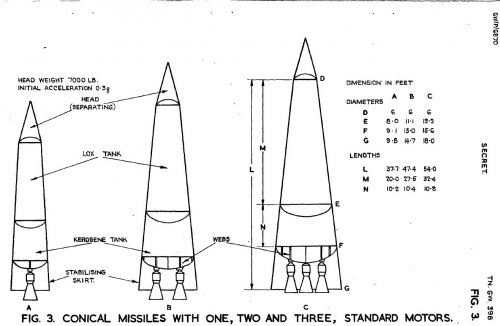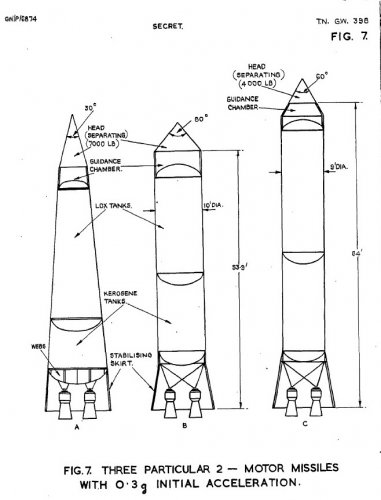RAF Nuclear Deterrent Forces by Humphrey Wynn
Chapter XXIII
Blue Streak and Blue Steel MK2
Pages 374-375
The missile envisaged was to be capable of being fired at targets up to 2,000nm distant, and of subsequent development to reach ranges of 2,500nm, though the Air Staff would accept a minimum range of 1,500nm; it was to be designed to carry a nuclear warhead, and intended for use from prepared sites in the UK and the Middle East initially, though ultimately in any part of the world. It was required to be in service “as soon as possible”, and the ASR was forwarded to the Ministry of Supply on 8 August 1955. Later that year, and early in 1956, several Air Staff papers were written, and meetings held, on the operational employment of Blue Streak.
The issuing of this ASR had followed some two years’ preparatory work, for “in August 1953 the Air Staff called for an evaluation of all possible to an Air Staff target for a strategic bombardment missile”, and “the industrial organisation for the development of [the] project was settled in April 1955” – the de Havilland Propellor Co being “nominated as the firm responsible for the co-ordination of the weapon system and design”. The de Havilland Aircraft Co were to be responsible for the airframe, Rolls-Royce for propulsion, Sperry Gyroscope Co for inertial guidance and Marconi for ground radar and communications link, while a special re-entry test vehicle was required for experimental work: this was Black Knight – to be designed and flown by RAE and produced by Saunders-Roe. Other possible main contractors considered by the Ministry of Supply were Bristol Aeroplane Co and English Electric. A Ballistic Missile Division was created at RAE to exercise technical supervision and assist the project.
Page 375-376
Reporting to the Air Council in July (1957), DCAS (Air Mshl Sir Geoffrey Tuttle) said that recent economy measures” had “necessitated a readjustment of the Blue Streak R&D programme, resulting in cancellation of the contracts for the Marconi radar guidance system and the English Electric insurance inertial guidance system”. The R&D time-scale had been extended, so that the first firing was scheduled for November 1960 and the first operational capability date was 1965.
Page 376
Under the arrangement at present envisaged, 23 test firings were proposed for completion by the end of 1963 and only the last ten would have the thrust-controlled motors required for full-range operational missiles.
Page 380
(this from 1958)
The Americans, he said, had agreed to a purchase of Thor without political strings; but since they were not going to develop a successor to it in the IRBM range, and since there was small prospect of anything of value to the UK emerging from a European missile project, it was clear that if the UK were to have its own independent nuclear deterrent in the late 1960s it would have to make it sown successor to the V-force and to Thor – if that were acquired. Blue Streak should be ready by 1965”; the V-force with Blue Steel should remain effective until then and could be followed immediately by Blue Streak, without the need to buy Thors, which “would not have an effective life of more than three years after 1965”. The alternative would be to decide to buy Thors, to abandon Blue Streak and start afresh with the development of a solid fuel rocket. But this would have disadvantages: it was doubtful whether a solid fuel rocket would be ready for deployment, and the large sums already invested in developing a liquid-fuelled motor would be wasted because the development of a solid-fuel motor would mean starting afresh. If Blue Streak were continued with, taking advantages of the smaller and lighter American warhead, anti-defensive devices and other improvements could be incorporated. Known solid fuels , the Minister added, “would have…less powerful thrust than contemporary liquid fuels and…be insufficiently powerful for launching space satellites”. On balance , he had regretfully come to the conclusion that there was no practical alternative to proceeding with Blue Streak”.
Page 381
The capabilities of Blue Streak were well known: it would have the right combination of range (up to 3,000miles), warhead and capacity to carry counter-measures; it could be deployed by 1965.
Page 390
“For strategic reasons”, the Minister of Defence wrote to the Home Secretary on 5 June 1959, “wide dispersal throughout the country will probably be necessary, geological conditions permitting. But on present information much of the eastern half of England appears to be geologically unsuitable”.
Rock masses 300-500ft thick were required (paper in Guided Weapons-Surface to surface Blue Streak/Thor (IIA/11/2/26).)
Regards,
Barry
Chapter XXIII
Blue Streak and Blue Steel MK2
Pages 374-375
The missile envisaged was to be capable of being fired at targets up to 2,000nm distant, and of subsequent development to reach ranges of 2,500nm, though the Air Staff would accept a minimum range of 1,500nm; it was to be designed to carry a nuclear warhead, and intended for use from prepared sites in the UK and the Middle East initially, though ultimately in any part of the world. It was required to be in service “as soon as possible”, and the ASR was forwarded to the Ministry of Supply on 8 August 1955. Later that year, and early in 1956, several Air Staff papers were written, and meetings held, on the operational employment of Blue Streak.
The issuing of this ASR had followed some two years’ preparatory work, for “in August 1953 the Air Staff called for an evaluation of all possible to an Air Staff target for a strategic bombardment missile”, and “the industrial organisation for the development of [the] project was settled in April 1955” – the de Havilland Propellor Co being “nominated as the firm responsible for the co-ordination of the weapon system and design”. The de Havilland Aircraft Co were to be responsible for the airframe, Rolls-Royce for propulsion, Sperry Gyroscope Co for inertial guidance and Marconi for ground radar and communications link, while a special re-entry test vehicle was required for experimental work: this was Black Knight – to be designed and flown by RAE and produced by Saunders-Roe. Other possible main contractors considered by the Ministry of Supply were Bristol Aeroplane Co and English Electric. A Ballistic Missile Division was created at RAE to exercise technical supervision and assist the project.
Page 375-376
Reporting to the Air Council in July (1957), DCAS (Air Mshl Sir Geoffrey Tuttle) said that recent economy measures” had “necessitated a readjustment of the Blue Streak R&D programme, resulting in cancellation of the contracts for the Marconi radar guidance system and the English Electric insurance inertial guidance system”. The R&D time-scale had been extended, so that the first firing was scheduled for November 1960 and the first operational capability date was 1965.
Page 376
Under the arrangement at present envisaged, 23 test firings were proposed for completion by the end of 1963 and only the last ten would have the thrust-controlled motors required for full-range operational missiles.
Page 380
(this from 1958)
The Americans, he said, had agreed to a purchase of Thor without political strings; but since they were not going to develop a successor to it in the IRBM range, and since there was small prospect of anything of value to the UK emerging from a European missile project, it was clear that if the UK were to have its own independent nuclear deterrent in the late 1960s it would have to make it sown successor to the V-force and to Thor – if that were acquired. Blue Streak should be ready by 1965”; the V-force with Blue Steel should remain effective until then and could be followed immediately by Blue Streak, without the need to buy Thors, which “would not have an effective life of more than three years after 1965”. The alternative would be to decide to buy Thors, to abandon Blue Streak and start afresh with the development of a solid fuel rocket. But this would have disadvantages: it was doubtful whether a solid fuel rocket would be ready for deployment, and the large sums already invested in developing a liquid-fuelled motor would be wasted because the development of a solid-fuel motor would mean starting afresh. If Blue Streak were continued with, taking advantages of the smaller and lighter American warhead, anti-defensive devices and other improvements could be incorporated. Known solid fuels , the Minister added, “would have…less powerful thrust than contemporary liquid fuels and…be insufficiently powerful for launching space satellites”. On balance , he had regretfully come to the conclusion that there was no practical alternative to proceeding with Blue Streak”.
Page 381
The capabilities of Blue Streak were well known: it would have the right combination of range (up to 3,000miles), warhead and capacity to carry counter-measures; it could be deployed by 1965.
Page 390
“For strategic reasons”, the Minister of Defence wrote to the Home Secretary on 5 June 1959, “wide dispersal throughout the country will probably be necessary, geological conditions permitting. But on present information much of the eastern half of England appears to be geologically unsuitable”.
Rock masses 300-500ft thick were required (paper in Guided Weapons-Surface to surface Blue Streak/Thor (IIA/11/2/26).)
Regards,
Barry


